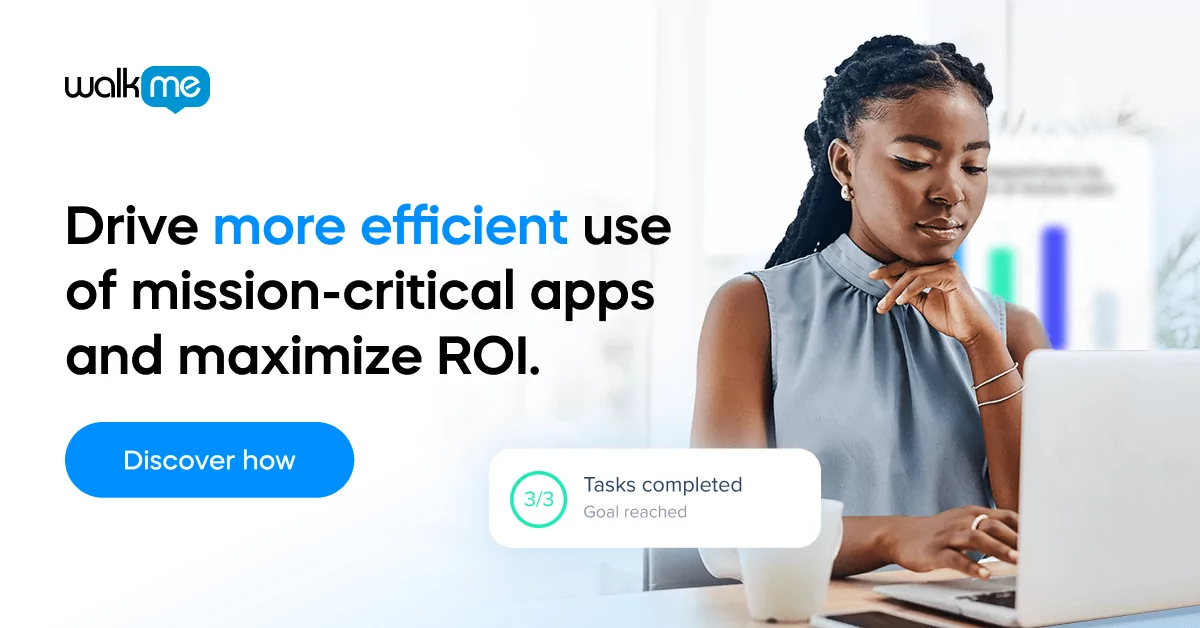Training software has taken a prominent place in the modern enterprise. The right training solutions can dramatically improve employee productivity, performance, and engagement.
The wrong training software, however, can result in “endless training” that delivers mediocre results and frustrates employees.
In this guide, we’ll cover training software inside and out.
Frequently asked questions and key concepts
Let’s start by laying the foundation and answering some of the most commonly asked questions about training software.
What is training software?
Training software is, as the name suggests, software specifically designed to help users become proficient in a certain domain.
In the modern enterprise, that proficiency usually refers to digital proficiency.
In the digital workplace, training software helps to:
- Improve and maintain employees’ digital skills
- Increase productivity and performance levels
- Maximize the utilization and ROI of an organization’s software tools
Since the modern workplace is undergoing continual transformation and change, training software is becoming more and more common each year.
Why do employees need training for their software?
The modern workplace is overflowing with digital software, which are themselves evolving day-to-day.
Training, therefore, is a necessity.
Effective employee training helps keep employees:
- Proficient – Proficiency refers to skill levels, knowledge, and abilities – the first step towards productivity. Improving proficiency is one of the main aims of software training.
- Engaged – Engagement refers to motivation, enthusiasm, and how proactively employees perform their duties. One way to improve engagement is by improving employee onboarding, software training, and other elements of the employee experience.
- Productive – Productivity depends on engagement, proficiency, the work environment, and a number of other factors, many of which can be influenced by the organization.
It is also important to note that there are risks for organizations that fail to adequately train their workers.

Ineffective training can:
- Lower productivity and performance levels
- Hinder digital transformation and adoption efforts
- Inhibit innovation and organizational change
Training software plays an important role in minimizing risks such as these. However, as we’ll see throughout this guide, training software can and should tackle a much more important issue.
What problem is it trying to solve?
Training software is the vehicle for employee training programs.
And, as mentioned, those training efforts are designed to maximize employee productivity and performance levels. But training software is really tackling a deeper issue: performance deficiencies caused by a lack of digital skills.
Today, that performance deficit is widening, thanks to disruptive digital technology, which is fueling digital transformation across the globe.
To keep up, organizations must transform the way they operate, by:
- Adopting new digital tools
- Incorporating those tools into daily operations
- Redesigning and renovating business strategies
Ultimately, in order to be effective, training software needs to do more than just train users on a specific tool – it must support organizations’ ongoing transformation efforts.
What are the common issues and pitfalls with training software?
Not all training software is created equal.
Some software delivers excellent results, skyrocketing employee productivity and performance.
Other software keeps employees in an endless “training limbo” that delivers mediocre results at best.
Problems with training software can arise from several sources:
- User experiences that are too complex
- Information that is irrelevant or out of context
- Training that is not interactive
- Lack of personalization
When it comes to digital software, traditional teaching methods tend to perform poorly. Lectures and classroom curricula, for instance, suffer from all of the problems mentioned above. They are delivered out of context, lack interactivity, and only a portion of the information will be immediately relevant to the end user.

Unfortunately, many training software solutions are simply content management systems – that is, they allow trainers to distribute and manage their training content. Although these systems certainly offer advantages over in-person training, they are still much less effective than digital adoption solutions (see below).
Why do companies find that training is ongoing and doesn’t end at onboarding?
There are several reasons why software training extends beyond onboarding:
- The digital work environment is dynamic and constantly evolving, which means that employees must re-skill each time a platform is upgraded or changed
- Enterprise-grade SaaS platforms are often complex and cannot be taught during the onboarding stage of the employee life cycle
- Employers that offer skills development opportunities are more likely to attract and retain talented workers
What should be clear by now is the fact that ongoing software training is a must, even after onboarding.
Organizations should not focus on “ending” training per se. Instead, they should focus on the results of their training efforts, such as:
- Employee proficiency, productivity, and performance
- Time-to-competency and time-to-productivity
- The costs and benefits of training programs
In short, software training should be viewed as an investment.
Training that is both endless and ineffective will create an endless budget drain … one that delivers lackluster ROI and mediocre productivity gains.
Why are productivity and performance affected by training issues?
The more effective the training approach, the more quickly people learn, the more they retain, and the better they perform.
And the reverse is also true – poor training reduces retention, engagement, and productivity.
To understand why we need to understand the different factors that influence training effectiveness.
Professionals that design training program should consider variables such as:
- How people learn. One model of learning, Edgar Dale’s “Cone of Experience,” that people retain only a small percentage of what they read, hear, and see. On the other hand, they retain much more of what they actually do. This becomes important when we compare different training methods, such as reading a book versus interactive software walkthroughs.
- Preferred learning modalities. Different people have different preferences when it comes to studying and learning. These are often referred to as learning styles or learning modalities. One such model includes four modalities: visual, auditory, physical, and social. A training approach that only accommodates one learning style would be less effective than one that accommodates several.
- The employee experience. The user experience is well-known in many business disciplines, from marketing to product design. Lately, the employee experience has entered the spotlight for the same reason – that experience impacts engagement, motivation, and happiness. These sentiments, in turn, affect employees’ performance and productivity.
- The forgetting curve. The forgetting curve is a model that describes knowledge retention. That is, it illustrates how long people remember what they have learned. Naturally, the shorter the time span between learning and application, the more likely trainees are to retain what they have learned.
- Relevance. According to one study, Americans only use 37% of what they learned in high school. The same concept holds true in any other training scenario – only a portion of what students learn will be relevant. This concept highlights how important it is to teach only the most relevant material.

Since employee training is an investment, organizations should evaluate effectiveness in terms of costs and benefits.
Why is training particularly difficult for large enterprises?
One major reason is that traditional training approaches are difficult to scale. The reason is simple: as training needs increase, so too do administrative costs.
Scaling classroom training to meet the needs of a large enterprise, for instance, would be extremely costly, as well as inefficient. The next alternative for most organizations is to use learning management systems.
These training software platforms allow trainers to manage content, record attendance, track student performance, and perform other necessary training functions.
Naturally, these platforms are designed for scale, but they suffer from the same problems associated with all online training.
That is, they:
- Are only as relevant as their content
- Must be continually updated as software is updated
- Are not interactive
- Cannot provide personalized, context-based information
- Require trainers who can track and evaluate trainees’ progress
Although these systems are built to be scalable, they are much less flexible than digital adoption platforms, an innovative type of training software that overcomes many of the problems mentioned above.
Why does digital training lead to digital adoption?
Software training is a means to an end – and that end is less about software proficiency than it is about an efficient, streamlined digital workplace.
Training, in other words, is designed to support larger business functions, such as:
Digital transformation
Digital disruption and innovation, as mentioned above, are catalyzing change throughout the global economy, pressuring organizations to adapt and transform. Such digital transformations inevitably entail the adoption of new digital technologies. And to succeed at adoption, effective training is a must.
Digital adoption
Digital adoption, covered in more detail below, means using digital technology for its intended purpose and to its fullest extent. That is, employees must be proficient with a tool and they must be able to use that tool’s capabilities fully.
The digital-first business
The digital-first organization leverages technology to exploit new business processes, new business functions, and new ways of delivering value to customers. Agile, lean, the customer experience, data-driven business processes – all of these are built upon digital technology and hinge upon its successful adoption.
The digital workplace
The contemporary workplace is vastly different from the workplace of just a few decades ago. Today’s workers can work remotely, collaborate online, automate repetitive tasks, learn online, and more. Like the organization as a whole, a streamlined digital workplace depends on the successful adoption of digital technology.

Employee onboarding, training, and development
The employee life cycle covers every interaction an employee has with a brand, from pre-hire communications to post-exit surveys. Automation and digital training have a significant impact on this cycle, touching almost every aspect of the employee experience.
Software training should not be the end goal.
Instead, it should be viewed as an investment that aims to maximize software performance, employee performance, and organizational performance.
Tips, strategies, and best practices for implementation
Let’s look at some tips and strategies that organizations can implement to improve the results of their training efforts.
Reduce information overload and cognitive overload
Though the abundance of information in today’s work world certainly has its advantages, information overload can also produce cognitive overload. And that overload, in turn, can produce stress, decreased job satisfaction, exhaustion, and more.
For years, designers have done their best to reduce cognitive load in software and websites. The more mental effort users must expend, after all, the greater the chances they will:
- Become mentally tired or frustrated
- Burn out
- Abandon a product or application
These dangers also apply when it comes to software training – or any other form of training, for that matter. This is especially true in the enterprise workplace, where complex SaaS platforms are commonplace.
Though organizations cannot redesign those SaaS platforms, they can simplify employee onboarding and training.
A few strategies for simplifying these experiences include:
- Prevent employee frustration with product tours that quickly introduce users to an application
- Reduce cognitive load by personalizing training programs
- Minimize extraneous information by providing information that is immediately relevant and applicable
- Increase productivity with software training tools that deliver just-in-time information
Later, we will explore how digital adoption platforms can be used to achieve all of these aims.
Implement training solutions that can scale
Many traditional teaching methods, such as classroom training, cannot scale. In certain circumstances, classroom training can be useful and practical. However, in-person training is simply impractical for on-the-job software training, especially for larger organizations.
One obvious alternative to face-to-face teaching is online delivery. Online teaching can be sent through video, text, audio, or a combination of these formats. While this approach is more scalable and affordable, it can also be problematic.

There are several reasons why:
- Course content must be updated continuously alongside software updates
- Human instructors must be hired or outsourced each time a curriculum is updated
- Online teaching tends to cover its topic comprehensively and generally, making it more difficult to personalize
- Users must take time to sift through online content, regardless of its format, in order to find the most relevant information
- This teaching method is passive, which decreases the rate of knowledge retention
Digital adoption solutions (see below) are the best way to avoid these obstacles.
As we will discover later, these solutions:
- Can be scaled effortlessly and quickly
- Offer immediately relevant information
- Personalize their training content to the needs of the individual user
- Are interactive and contextualized, allowing users to “learn by doing” and consequently retain more
In short, these platforms offer many of the same benefits as one-on-one training, yet they can operate without limitations on any scale.
Treat software training like an investment
There are several reasons why training software should be viewed as an investment:
- Enterprise software is itself an investment, since it impacts employee performance and organizational performance
- Enterprise-grade tools require a period of onboarding and training, which the organization must fund
- The effectiveness of that training directly impacts employees’ proficiency, productivity, and performance
In other words, employee training affects the ROI of an enterprise’s software investments. For that reason, it pays to understand and assess the potential costs and benefits associated with those investments.
The benefits of effective training, as mentioned earlier, can include:
- Improved employee proficiency, productivity, and performance
- A better onboarding and training experience
- More motivated, engaged employees
- Decreased friction, frustration, and burnout
- Greater utilization of the target software
- Higher software ROI
These rewards should also be balanced against costs and limitations, such as:
- The cost of training software
- Technical support costs
- Costs associated with scaling the solution
- The time it takes workers to become proficient, competent, and productive – during which time employees are operating below performance expectations
Software is, at the end of the day, one of the many variables that affect an organization’s performance. And since that software plays such a critical role in employees’ day-to-day workflow, training itself should be viewed and treated as an important investment.
Look at the bigger picture – digital adoption
Organizations around the world invest millions on digital tools. But recouping that investment hinges on employees’ ability to use that software.
Employee training, therefore inevitably leads to larger strategic aims, such as:
Improving employee productivity
Employees are more productive when they are engaged in the workplace and when they are proficient with their digital tools. Employee productivity, in turn, impacts organizational effectiveness and performance.
Streamlining digital workflows
Most workers use a range of tools in their daily workflows, which means that workers must be proficient across multiple platforms in order to be productive.
Maximizing software utilization
Software ROI depends on how fully workers utilize a platform. When workers only use half of a software application’s features, for instance, they will only realize a portion of its potential value.
Increasing software ROI
Software ROI depends in part on software utilization, as just mentioned. It also depends on other factors that can be influenced by employee training, such as proficiency, productivity, and the user experience.
For reasons such as these, it is necessary to expand the scope of software training and focus on digital adoption, not just training.
Digital adoption is defined as:
Achieving a state in which digital tools are being used as intended, and to their fullest extent.
In other words, to generate real ROI, software must be used for its intended purpose.
If employees only use half of a software’s functionality, or if they only use software occasionally, then they have not fully adopted it.
The result: partial digital adoption and partial return on investment. Making the commitment to digital adoption is a prerequisite for success, but this is just the first step. In order to achieve true digital adoption, it is necessary to implement a digital adoption solution.
Industry research proves Digital Adoption Platforms are the future of training
Here are five reasons why digital adoption – and digital adoption software – represent the future of software training.
1. For the modern workforce, perpetual learning is mandatory
For several years now, major research firms have recognized the need for employee-centric learning within organizations.
Deloitte’s research found that 84% of executives viewed employee learning as important or very important. And according to the World Economic Forum, everyone will need an extra 101 days of learning by 2022.
Continuous learning is critical for the success of both employees and organizations. After all, organizational performance depends directly on employee performance.
However, tackling this problem is not merely a matter of implementing a new training program.
Thanks to the ongoing emergence of new technology, such as AI and automation, digital disruption will only continue to accelerate.
And as a result, the need for digital skills will also accelerate.
2. In the coming years, the digital skills gap will continue to widen – unless organizations intervene
In an extensive report on automation, McKinsey predicted that the growth of automation technologies will put pressure on workers to upskill.
Low-skill workers will face more disruption and job displacement, they claim. However, “competition for high-skill workers will increase” and that “the decline in work activities that mainly require basic cognitive skills is the largest across our five categories.
These predictions are certainly in line with many other assessments of today’s widening digital skill gap.
In a survey of global executives, for instance, PwC found that the lack of key skills is a “top 3” concern for 79% of CEOs. And many other sources claim that global workforces are facing a digital skills crisis.
There are several solutions to this problem – such as improving hiring practices and implementing modern training software.
The most innovative, forward-thinking organizations, however, take a comprehensive, multi-pronged approach that is rooted in digital transformation.
3. According to Deloitte, successful digital transformation depends on digital adoption
Deloitte’s digital industrial transformation framework includes several steps, one of which is digital adoption. During this comprehensive digital transformation process, organizations should solve such questions as:
- What capabilities are needed to win?
- Which are new versus existing?
- How should capabilities be configured?
- Where should they be executed?
- Who has ownership and decision rights?
The development of these digital capabilities is, of course, only part of the picture. However, it is a vital part.
Unless organizations adopt technology effectively – and adopt the right technology – their digital transformation efforts will be much more likely to fail.
4. Adopting the right technology can double the chances of successful digital transformation, says McKinsey
McKinsey’s research pinpointed several steps that an organization can take which can dramatically increase the likelihood that their digital transformations will succeed.
These include:
- Adopting digital tools that “make information more accessible”
- Implementing self-serve technologies for employees, the organization, and business partners
- Modifying standard operating procedures to include new technologies
- Increasing data-based decision making
As we will discover later, digital adoption platforms meet many of these criteria – making them an ideal solution for facilitating digital transformation.
5. Gartner has identified “digital adoption solutions” as a major emerging category of training software
A report by Gartner found that digital adoption solutions are a new, but vital, category of training software. In their report, they demonstrated that digital adoption solutions – that is, digital adoption platforms – can vastly improve sales performance.
Gartner’s research found that digital adoption platforms can:
- Save time and money by improving productivity
- Improve the user experience with analytics
- Incorporate continuous development for tenured sellers
From Gartner’s report, we can see that digital adoption solutions are a very promising, effective training solution.
However, when looking at the bigger picture, it is clear that digital training software plays a much more important role in the modern workplace … they facilitate perpetual learning, digital adoption, and digital transformation.
Why Digital Adoption Platforms are the most advanced option
Earlier, we explored the benefits of interactive training, contextualized learning, just-in-time information delivery, and similar training techniques.
Face-to-face training, such as classroom training, can deliver on many of these counts, but it is not scalable. Online teaching can scale, but it sacrifices most of the other benefits. It loses out in terms of context, interactivity, and personalization.
Digital adoption platforms (DAPs), however, can meet all of these needs.
This new category of software trains users directly inside of the target application, which significantly enhances an organization’s ability to achieve true digital adoption.
Five benefits of using Digital Adoption Platforms for software training
There are quite a few benefits to using digital adoption platforms in the workplace.
Here are five of the biggest:
An end to endless, ineffective software training
Traditional training approaches can’t keep up with today’s ever-changing digital workplace. The pace of change is too fast and training needs are too great. Digital adoption platforms, however, leverage cutting-edge technology to outpace these inefficient approaches – putting an end to endless, ineffective training.
Accelerated time-to-competency and time-to-productivity
Digital adoption platforms shorten learning timelines because they deliver exactly the right information in the moment of need. This dramatically reduces cognitive load, streamlines the user experience, and decreases the time it takes to become competent and productive.
Increased employee productivity and performance
Better training software increases trainees’ proficiency levels, which in turn improves productivity and performance. The bottom-line impact for the organization, of course, is a greater return on its software investment.
Improved software utilization and ROI
Software ROI depends a great deal on employee productivity and performance. And that performance, as has been covered, depends on the organization’s ability to close the digital skills gap.
True digital adoption
Digital adoption strategies are designed to enable a seamless digital workplace, one with digitized business processes, a digital-first business strategy, a forward-thinking digital transformation agenda, and a proficient, productive workforce.
To see how digital adoption platforms can deliver these results, let’s learn a bit more about how these tools work.

How Digital Adoption Platforms can transform software training
Digital adoption platforms are UX training layers that operate independently of their target software program.
When using WalkMe for Salesforce, for instance, users can be trained directly inside the CRM platform, automatically and without any human intervention. This innovative technology overcomes all of the challenges that other training software cannot.
Namely, these platforms can be used for:
Interactive, contextualized learning
In-app walkthroughs and product tours give users hands-on experience with the target software. They can “learn by doing,” which, as we saw earlier, greatly improves knowledge retention and accelerates learning.
Information at the moment of need
By providing information only when it is needed, digital adoption platforms completely eliminate the “forgetting curve.” It also decreases the need for technical support and helps to cultivate a culture of self-reliance.
Software analytics
Analytics track how employees use an application and interact with the training walkthroughs. These insights can be used to implement corrective action and improve training efforts over time, further increasing software utilization and ROI.
These features, combined under a single dashboard, form a powerful training solution that can totally transform an organization’s training efforts.
Training for the modern enterprise
In this guide, we have learned a great deal about training software’s role in the modern enterprise.
We have seen that:
- Training software is needed to help employees become proficient and productive with many enterprise-grade software tools
- Employee training inevitably leads to adoption, which aims at maximizing software productivity, utilization, and ROI
- Traditional training approaches cannot meet those training needs in today’s dynamic, constantly changing digital workplace
- Digital adoption platforms are training solutions that leverage innovative technology to provide interactive, contextualized learning to users … vastly outperforming other training approaches
For more information on digital adoption platforms, visit WalkMe’s main website or the WalkMe blog, which covers topics that include digital adoption, employee training, and more.


